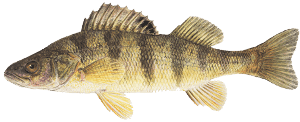Characteristics

They eat small fish and invertebrates. Since this fish is great fish to eat, they must be careful because they fall prey to Largemouth Bass, Northern Pike and especially Walleye. Seasons where Walleye’s are very productive usually mean that they are eating an abundant of Perch, which makes fishing for them poor.
Walleyes are not the only Yellow Perch eating species, anglers also love to eat them. Therefore, fishing for this fish can be fun especially when you are fishing to create a feast. Practicing Catch N’ Release helps in replenishing Yellow Perch.
Habitat
During the spring time Perch will gravitate toward warm, gravel areas. During late spring they tend to gravitate toward weedy areas. Perch are found in clear and stained lakes. Many are found in spring feed inland lakes. They tend to follow minnows as they are forge fish, which means they will follow the same species.
Perch tend to school together so if you find one you’re likely to find more. The warmer the weather gets the warmer the water gets. Smaller Perch will be found in warmer water. Larger Perch will be found in colder water. Warmer water means they are located toward the shoreline. Colder water means they are found in deeper areas.
Perch spawn in shallow rocky sandy bottoms. If Perch spawn in rivers they tend to leave their spawning beds because of the strong currents in the rivers. If they spawn in a lake, they tend to stay by their spawning beds to protect their eggs.
Equipment
The best suggested equipment for Perch is a light weight rod with a 6 pound test line and a spinning reel. Hooks, night crawlers, bobbers, slip bobbers and jigs are the best bait/lures to use to catch Perch.
Tips for Fishing
If you fine one Perch you’re likely to find more as they school together. If the water is warmer stay within the weed line, which is about 3-5 feet deep or on the top of the weeds, which is about 5-8 feet deep. Or stay outside of the weed line, which can be about 8-12 feet deep.
If the water is colder, it is recommended that you fish the smaller weeded areas because that is where you’ll find the smaller feeding fish that Perch are attracted to.
Perch is a great fish to eat. So, if you are interested in having a shore lunch, fish for Perch. You can also catch Perch to cook a great meal after your fishing adventure.

